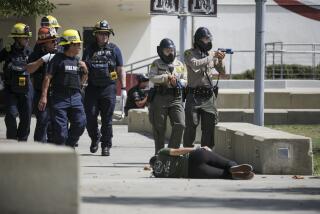Cleaning Up Toxic Classrooms
California’s environmental protections are among the nation’s strongest, but even here some potentially toxic chemicals can fall between the regulatory cracks. Recent studies of some portable classrooms, hastily assembled to make room for class-size reduction, show that they release carcinogens like benzene and formaldehyde at up to six times the level considered safe in the state of Washington, the only state with standards for portable classroom air quality.
One problem is that school administrators have not been aware of the need to ventilate the classrooms before letting children occupy them, and after as well, so that toxic chemicals can evaporate. Another is that school districts have perhaps too readily accepted manufacturers’ arguments that toxins like arsenic and formaldehyde cannot be removed from building materials for the trailer-like structures.
A pending bill by Assemblyman Kevin Shelley (D-San Francisco) is strong at the core but goes too far. It would require the state to review the health effects of portable classrooms and recommend any warranted changes in use or design. That part of the bill deserves support. Gov. Gray Davis does support this provision, but is rightly said to be balking at two other parts of Shelley’s bill. One, calling for a statewide effort to help school administrators reduce students’ and teachers’ exposure to toxic chemicals, would require already overburdened schools to conduct cost-benefit analyses and post warning signs every time they use pesticides--even ones not regarded as toxic--on school property. There are simpler, more common-sense changes to be made, such as spraying bushes with pesticides at night, rather than in the morning while kids are coming to class.
Davis is also right to balk at a second provision in Shelley’s bill that would flatly ban schools’ use of any chemicals the state has identified as potentially carcinogenic under Proposition 65, passed by voters in 1986.
The agriculture industry correctly argues that Proposition 65 was not intended to ban all uses of potentially toxic chemicals, but rather to educate Californians about proper use. And environmentalists are right that schools should seek alternatives to chemicals for ridding schools of rats, cockroaches and other disease-carrying pests. In the meantime, though, the requirement in Shelley’s bill that warning signs be posted even where there is no evidence of danger could needlessly stoke parents’ fears. And the Shelley bill goes too far in banning pesticides that can be used safely.
A state legislative analyst observed that the bill requires legislators to make “value choices about the extent to which perceived risks justify the expenditures of scarce social and educational resources.” Pesticides need to be used more carefully around schools, but eliminating them altogether is not the right first step. The right first step is to review and quantify to determine the extent of the problem of pesticides in schools.
More to Read
Get the L.A. Times Politics newsletter
Deeply reported insights into legislation, politics and policy from Sacramento, Washington and beyond. In your inbox three times per week.
You may occasionally receive promotional content from the Los Angeles Times.










